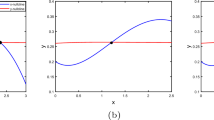Abstract
Persistence-extinction in simple food chains modelled by Lotka-Volterra dynamics is governed by a single parameter which depends upon the interspecific interaction coefficients, the intraspecific interaction coefficients, and the length of the food chain. In persistent systems with nonzero carrying capacity, two new features predominate. Trophic level influence factors relate persistence on different trophic levels and determine, in conjunction with the persistence parameter, the magnitude of persistence. Equilibrium component ordering, which results in persistent systems, mandates once again that systems need to be studied on the complete ecosystem level; static field measurements reflect species location in the food chain, the total length of the food chain and assume characteristics according to these factors.
Similar content being viewed by others
Literature
Coste, J., J. Peyrand and P. Coullet. 1978. “Does Complexity Favor Existence of Persistent Ecosystems?”J. Theor. Biol.,73, 359–362.
Freedman, H. I. and P. Waltman. 1977. “Mathematical Analysis of Some Three Species Food-Chain Models.”Math. Biosci.,33, 257–276.
Goh, B. S. 1977. “Global Stability in Many-Species Systems.”Am. Nat.,111, 135–143.
Goodman, D. 1975. “The Theory of Diversity-Stability Relationships in Ecology.”Q. Rev. Biol.,50, 237–266.
Harrison, G. W. 1979. “Global Stability of Food Chains.”Am. Nat., in press.
Holden, C. 1977. “Endangered Species: Review of Law Triggered by Tellico Impasse.”Science,196, 1426–1428.
Holling, C. S. 1973. “Resilience and Stability of Ecological Systems.”Ann. Rev. Econ. Syst.,4, 1–23.
LaSalle, J. P. 1976.The Stability of Dynamical Systems. Philadelphia: SIAM.
May, R. M. 1974.Stability and Complexity in Model Ecosystems. 2nd Ed. Princeton: Princeton University Press.
Maynard Smith, J. 1974.Models in Ecology. Cambridge: Cambridge University Press.
Nemytskii, V. V. and V. V. Stepanov. 1960.Qualitative Theory of Differential Equations. Princeton: Princeton University Press.
Paine, R. T. 1966. “Food Web Complexity and Species Diversity.”Am. Nat.,100, 65–75.
Patten, B. C. 1974. “The Zero State and Ecosystem Stability.”Proc. 1st Int. Cong. Ecol., The Netherlands: The Hague.
Rescigno, A. and K. G. Jones. 1972. “The Struggle for Life: III. A Predator-Prey Chain.”Bull. Math. Biophys.,34, 521–532.
Saunders, P. T. and M. J. Bazin. 1975. “On Stability of Food Chains.”J. Theor. Biol.,52, 121–142.
Yorke, J. A. and W. N. Anderson, Jr. 1973. “Predator-Prey Patterns.”Proc. Natn. Acad. Sci., U.S.A.,70, 2069–2071.
Author information
Authors and Affiliations
Rights and permissions
About this article
Cite this article
Gard, T.C., Hallam, T.G. Persistence in food webs—I Lotka-Volterra food chains. Bltn Mathcal Biology 41, 877–891 (1979). https://doi.org/10.1007/BF02462384
Received:
Revised:
Issue Date:
DOI: https://doi.org/10.1007/BF02462384




